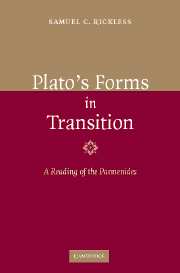Book contents
- Frontmatter
- Contents
- Preface
- List of abbreviations
- Introduction
- Chapter 1 The theory of forms
- Chapter 2 The theory criticized
- Chapter 3 The theory modified: methodology
- Chapter 4 The First Deduction
- Chapter 5 The Second Deduction
- Chapter 6 From the Appendix to the Fourth Deduction
- Chapter 7 From the Fifth to the Eighth Deduction
- Conclusion
- References
- Index of forms discussed
- Index of Deductions
- Index of passages cited
- General index
Chapter 3 - The theory modified: methodology
Published online by Cambridge University Press: 22 September 2009
- Frontmatter
- Contents
- Preface
- List of abbreviations
- Introduction
- Chapter 1 The theory of forms
- Chapter 2 The theory criticized
- Chapter 3 The theory modified: methodology
- Chapter 4 The First Deduction
- Chapter 5 The Second Deduction
- Chapter 6 From the Appendix to the Fourth Deduction
- Chapter 7 From the Fifth to the Eighth Deduction
- Conclusion
- References
- Index of forms discussed
- Index of Deductions
- Index of passages cited
- General index
Summary
In the first two chapters I set out the high theory of forms (as outlined by middle-period Socrates), described the subtle changes to this theory effected by young Socrates in his speech at Parmenides 128e5–130a2, and reconstructed the criticisms of the theory offered by Parmenides at 130b1–134e8. At 133b1 Parmenides describes the last of these criticisms as a great difficulty [aporia], and were the dialogue as a whole similar to those of Plato's early period, we would expect it to end soon after Socrates confesses to seemingly irredeemable perplexity. But, as the rest of the dialogue reveals, Parmenides has only just begun to flex his logical muscles. The main question on the minds of those who have read and understood Parmenides' criticisms of the higher theory is whether there is any way to save this theory, whether it be by attacking the validity of the criticisms themselves, or, with their validity having been acknowledged, by modifying the theory without destroying its major theoretical advantages (such as fruitfulness and explanatory power).
The purpose of this chapter is to analyze the method Parmenides describes as the means by which (most of) the criticisms he has raised may be answered. Parmenides' description of his method occupies the transitional section at Parmenides 134e9–137c3. With a proper understanding of this section, it becomes possible to read the second part of the Parmenides as a direct and rational response to the problems raised in the first part of the dialogue.
- Type
- Chapter
- Information
- Plato's Forms in TransitionA Reading of the Parmenides, pp. 95 - 111Publisher: Cambridge University PressPrint publication year: 2006



